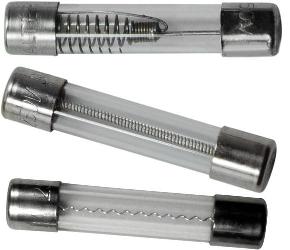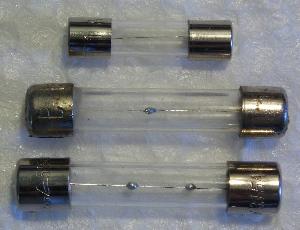The MGA With An Attitude
SLOW BLOW FUSES - ET-102
ET-102 explains the SLOW BLOW FUSES used in the MGA and why you should not use "standard" fuses. -- Strictly speaking, these are not (technically) slow blow fuses. See the finer details at bottom of page.
At 06:49 AM 5/15/02 -0700, Scott Willis wrote:
>"I broke a 35 amp fuse in my MGA box. It's shorter than all other fuses I have. Is that an odd size that I have to order from Moss etc. or should it be avail at auto zone?"
 DO NOT USE A STANDARD 35 AMP FUSE. It is not an odd size, but it is an odd type of fuse. It is actually a 17/35 amp slow blow fuse that will carry 17 amps indefinitely but will blow immediately at 35 amps. If you install a regular 35 amp fuse you run the risk of frying your wiring harness. This "special" fuse may carry 20 amps for a minute or so before it blows. The more current it sees the quicker it will blow, but it may even carry a 30 amp spike for a couple of seconds without blowing.
DO NOT USE A STANDARD 35 AMP FUSE. It is not an odd size, but it is an odd type of fuse. It is actually a 17/35 amp slow blow fuse that will carry 17 amps indefinitely but will blow immediately at 35 amps. If you install a regular 35 amp fuse you run the risk of frying your wiring harness. This "special" fuse may carry 20 amps for a minute or so before it blows. The more current it sees the quicker it will blow, but it may even carry a 30 amp spike for a couple of seconds without blowing.
The reason for using the slow blow type of fuse is because the wiring size is relatively small compared to the current load it is expected to carry. The MGA only has two fuses, and one of those (the 25/50 fuse) is dedicated just to the horn. Everything else in the car that _IS_ fused (not everything mind you) runs through the 17/35 fuse, and some of the wiring is only 18 gauge. If you had a short in a tail light fixture you could draw perhaps 30 amps continuously and never blow the 35 amp regular type fuse. Even though you have a dead short the current may never go higher, because of the resistance of the long length of small gauge wire. Drawing 30 amps continuously on the (small) 18 gauge wire will likely make the wire so hot as to melt down the insulation. The 17 amp slow blow fuse takes care of this condition.
Addendum, 12 Oct 2016:
Since a few people are being a bit picky, these Lucas fuses are not technically slow blow fuses. They are rated differently from the American standard fuses. The American rated 20-amp fuse will blow instantly at 20-amps. Also fuses have a rather wide tolerance in actual failure current of maybe +/-20%. So the 20-amp fuse is intended to carry only 10 to 15-amps continuously, or 10-amps running with 15-amp surge on start-up.
The Lucas fuse (and most European standards) are "dual rated", such that the 17/35 fuse is intended to carry 17-amps continuously and will blow instantly at 35-amps. Problem is, in between the two numbers the actual blow time is somewhat unpredictable. The theoretical blow time can be charted on a graph of current vs. time, and it may look very convincing, but the tolerance involved allows the curve to vary +/-20%, so the actual blow time at the elevated current level can be variable. But the point is that in this elevated current range (above continuous rating but below instant blow rating) there will be some time delay before it blows. This allows for a slight overload short term, or a higher spike current (less than 100% excess) for a brief instant without blowing the fuse. This is why the Lucas fuses are commonly referred to as slow blow fuses.
By appearance, a fast blow (normal) fuse is almost always a straight wire inside, while slow blow fuses will usually be something different than the straight wire. If a straight wire fuse is not specifically marked as fast of slow blow, there is no way to know what type it is without the manufacturer's spec sheet in hand.
 The real slow blow fuse can be a variety of different designs depending on the intended timing characteristics. It may have a small coiled resistance wire (spring) attached to a thermal mass which in turn has a low melting temperature. With elevated current the coil wire heats the thermal mass for some time until the thermal mass will eventually melt, at which time the spring pulls the conductor apart to kill the current.
The real slow blow fuse can be a variety of different designs depending on the intended timing characteristics. It may have a small coiled resistance wire (spring) attached to a thermal mass which in turn has a low melting temperature. With elevated current the coil wire heats the thermal mass for some time until the thermal mass will eventually melt, at which time the spring pulls the conductor apart to kill the current.
Or there maybe a thin wire coiled around an insulating carrier. This wire may carry an excess current for some time while it is heating up, and if the excess does not last too long it may cool down to begin the process anew. If the excess current persists, the wire can heat up enough for adjacent coils to heat each other so the cumulative effect is a blown wire once it gets hot enough (therefore the time delay). Given a higher spike of current the thin wire can blow instantly.
 Another slow blow fuse is the "M" type (named for the inventor). This has a small blob of dissimilar metal "soldered" onto the fuse wire. As the "blob" heats up and melts it diffuses (blends or alloys) with the main wire to change composition and melting temperature of the wire, at which time the wire melts and breaks the circuit. This action provides a time delay function at slightly excess current, while the main wire will blow instantly at significantly higher excess current.
Another slow blow fuse is the "M" type (named for the inventor). This has a small blob of dissimilar metal "soldered" onto the fuse wire. As the "blob" heats up and melts it diffuses (blends or alloys) with the main wire to change composition and melting temperature of the wire, at which time the wire melts and breaks the circuit. This action provides a time delay function at slightly excess current, while the main wire will blow instantly at significantly higher excess current.
|